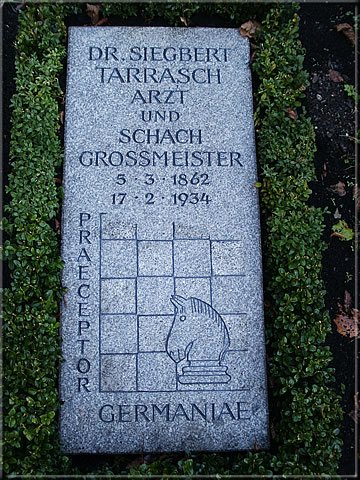


Siegbert Tarrasch was born in Wrocław on 5 March 1862. At the age of 15, as a grammar school pupil, he learned to play chess and transmitted his enthusiasm to his classmates. Eventually they got so strong at the game that they competed with adult players at the Fischer & Busch chess café on Königsplatz. Tarrasch soon became one of the best players in Wrocław.
Tarrasch moved to Berlin to study medicine and became friends with Berthold Lasker, also a medical student and a very strong chess player. Bertold Lasker brought his younger brother Emanuel with him at some point.
They all played regularly in the numerous chess cafés in Berlin. Tarrasch was probably the best player of this triumvirate, but Emanuel Lasker quickly caught up with him.

Tarrasch began his tournament career around 1881, and in the 1890s took part mainly in the tournaments organized by the German Chess Federation. He won the Master Tournament of the Bavarian Chess Federation in 1888, the Master Tournament of the 6th DSB Congress in 1889, the Master Tournament of the 6th Congress of the British Chess Association in 1890, the Master Tournament of the 7th DSB Congress in 1892 and the Master Tournament of the 9th DSB Congress in 1894. Tarrasch finished the super-tournament of the Hastings Chess Congress in 1895 in fourth place behind Harry Nelson Pillsbury, Mikhail Chigorin and Lasker. Tarrasch turned down the invitation to the Master Tournament in St. Petersburg.
By the beginning of the 1890s at the latest, Tarrasch was one of the best players in the world. Emanuel Lasker, World Champion since 1894, then replaced him, but Tarrasch still belonged to the world elite until World War I.
Tarrasch had turned down an invitation to face Wilhelm Steinitz in a World Championship match to be played in Cuba in 1892. After Lasker became World Champion, Tarrasch challenged him, but Lasker declined at first. In 1904 Lasker finally accepted the challenge, but the match fell through because Tarrasch had injured himself while skating. Many chess followers — and Lasker himself — thought this was a pretext and suspected that Tarrasch could not afford the prize purse. In the end, the two top German players did compete for the World Championship in 1908, but Tarrasch had already passed his zenith and clearly lost the match. Tarrasch won three, lost eight and drew five games.
After his studies, Siegbert Tarrasch moved to Nuremberg and practiced medicine from 1887 to 1914. Then he went to Munich.
Tarrasch died of pneumonia on 17 February 1934 at the age of 71. After the Second World War, his grave in Munich’s North Cemetery fell into oblivion until it was rediscovered in 1995 by Alfred Schattmann. Together with the chess fans from SK Tarrasch-Munich and Tarrasch’s grandson Rudolf Gall, Schattmann ensured that the grave was restored. It will soon be renovated once again.

Tarrasch’s new grave

Tarrasch vs Chigorin (1893)